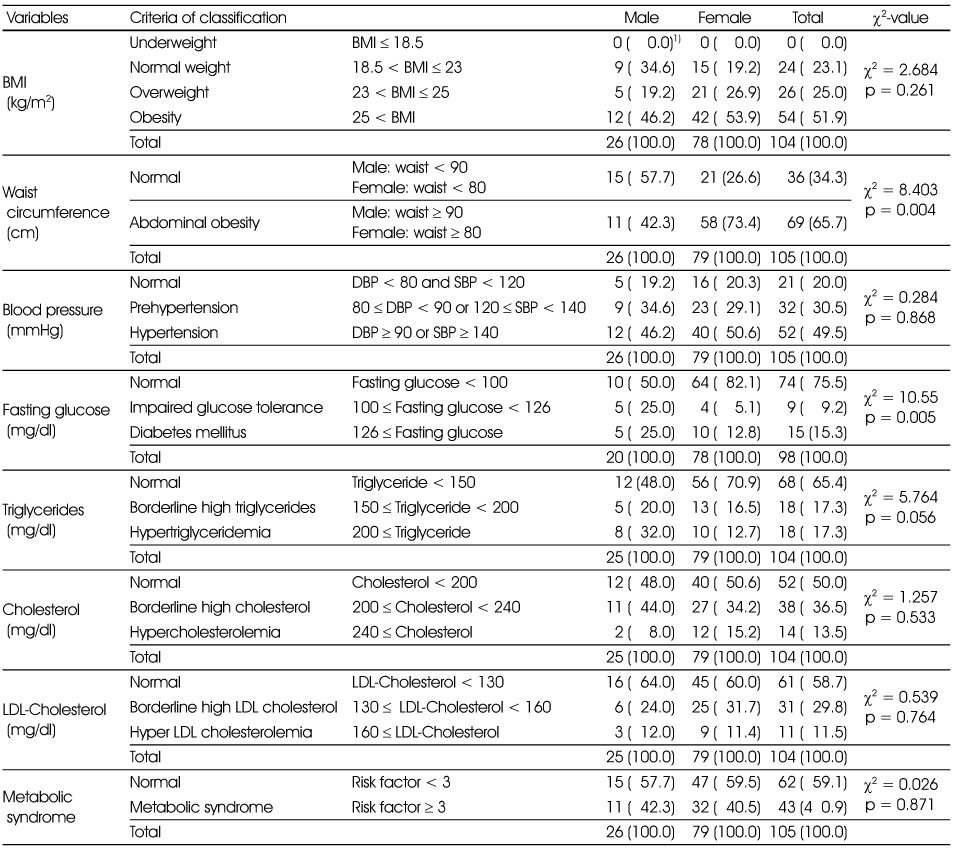Articles
- Page Path
- HOME > Korean J Community Nutr > Volume 19(1); 2014 > Article
-
Original Article
- Relationships among Serum Adiponectin, Leptin and Vitamin D Concentrations and the Metabolic Syndrome in Farmers
- Seo-Eun Yeon, Hee-Ryoung Son, Jung-Sook Choi, Eun-Kyung Kim
-
Korean Journal of Community Nutrition 2014;19(1):12-26.
DOI: https://doi.org/10.5720/kjcn.2014.19.1.12
Published online: February 28, 2014
Department of Food and Nutrition, Gangneung-Wonju National University, Gangwon-do, Korea.
1National Academy of Agricultural Science, Rural Development Administration, Suwon, Korea.
- Corresponding author: Eun Kyung Kim, Department of Food & Nutrition, Gangneung-Wonju National University,7 Jukheon road, Gangneung, Gangwon-do 210-702, Korea. Tel: (033) 640-2336, Fax: (033) 640-2330, ekkim@gwnu.ac.kr
Copyright © 2014 The Korean Society of Community Nutrition
This is an Open-Access article distributed under the terms of the Creative Commons Attribution Non-Commercial License (http://creativecommons.org/licenses/by-nc/3.0/) which permits unrestricted non-commercial use, distribution, and reproduction in any medium, provided the original work is properly cited.
- 1,066 Views
- 1 Download
- 2 Crossref
Figure & Data
REFERENCES
Citations

- Association of Serum Adiponectin Biomarker with Metabolic Syndrome Components in Koreans with Extremely High HDL Cholesterol Levels in General Health Checkup
Hyun Suk Yang, Gun-Hyuk Lee, Donghwan Kim, Kyeong Ryong Lee, Mina Hur
Metabolites.2022; 12(11): 1086. CrossRef - The Measurements of the Resting Metabolic Rate (RMR) and the Accuracy of RMR Predictive Equations for Korean Farmers
Hee-Ryoung Son, Seo-Eun Yeon, Jung-Sook Choi, Eun-Kyung Kim
Korean Journal of Community Nutrition.2014; 19(6): 568. CrossRef
The distribution of subjects by the gender and by the age group
1) N (%)
2) Mean ± SD
Anthropometric measurements of subjects by the gender
1) Mean ± SD
2) Body fat (%) measured by Inbody 720
3) Muscle (kg) calculated by Heymsfield's formular
4) Muscle (%) = [Muscle (kg) / Body weight (kg)] × 100
*: p < 0.05, **: p < 0.01, ***: p < 0.001 Significantly different between male and female by t-test
Fasting blood glucose levels and blood lipid profiles of subjects by the gender
1) Mean ± SD
2) Atherogenic index = (Total cholesterol - HDL cholesterol) / HDL cholesterol
*: p < 0.05 Significantly different between male and female by t-test
Serum adiponectin, leptin and 25(OH)vitamin D concentrations of subjects by the gender
1) Mean ± SD
**: p < 0.01, ***: p < 0.001 Significantly different between male and female by t-test
Prevalence of chronic diseases in the subjects
1) N (%)
Comparison of fasting blood glucose concentrations and lipid profiles in subjects with and without metabolic syndrome
1) MS (-): without metabolic syndrome
2) MS(+): with metabolic syndrome
3) Mean ± SD
*: p < 0.05, **: p < 0.01, ***: p < 0.001 Significantly different between MS (-) and MS (+) by t-test
†††: p < 0.001 Significantly different between male and female by t-test
Comparison of serum adiponectin, leptin and 25(OH)vitamin D concentrations in subjects with and without metabolic syndrome
1) MS (-): without metabolic syndrome
2) MS (+): with metabolic syndrome
3) Mean ± SD
*: p < 0.05, **: p < 0.01 Significantly different between MS (-) and MS (+) by t-test
†: p < 0.05, ††: p < 0.01, †††: p < 0.001 Significantly different between male and female by t-test
Pearson's correlation coefficients of serum adiponectin, leptin, leptin to adiponectin ratio and serum 25(OH)vitamin D concentration with study variables
1) Pearson's correlation coefficient (r)
*: p < 0.05, **: p < 0.01, ***: p < 0.001 Significantly correlated
1) N (%) 2) Mean ± SD
1) Mean ± SD 2) Body fat (%) measured by Inbody 720 3) Muscle (kg) calculated by Heymsfield's formular 4) Muscle (%) = [Muscle (kg) / Body weight (kg)] × 100 *: p < 0.05, **: p < 0.01, ***: p < 0.001 Significantly different between male and female by t-test
1) Mean ± SD 2) Atherogenic index = (Total cholesterol - HDL cholesterol) / HDL cholesterol *: p < 0.05 Significantly different between male and female by t-test
1) Mean ± SD **: p < 0.01, ***: p < 0.001 Significantly different between male and female by t-test
1) N (%)
1) MS (-): without metabolic syndrome 2) MS(+): with metabolic syndrome 3) Mean ± SD *: p < 0.05, **: p < 0.01, ***: p < 0.001 Significantly different between MS (-) and MS (+) by t-test †††: p < 0.001 Significantly different between male and female by t-test
1) MS (-): without metabolic syndrome 2) MS (+): with metabolic syndrome 3) Mean ± SD *: p < 0.05, **: p < 0.01 Significantly different between MS (-) and MS (+) by t-test †: p < 0.05, ††: p < 0.01, †††: p < 0.001 Significantly different between male and female by t-test
1) Pearson's correlation coefficient (r) *: p < 0.05, **: p < 0.01, ***: p < 0.001 Significantly correlated

 KSCN
KSCN








 Cite
Cite


